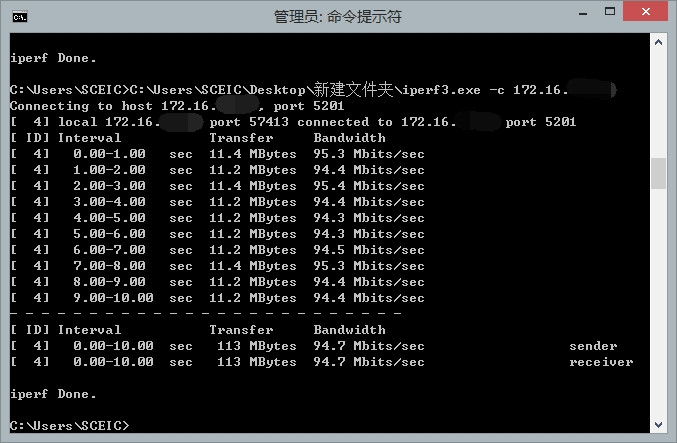本文將介紹如何使用工具iperf進行帶寬測試。
iperf是一個比較好用網絡性能測試工具,可以測試最大TCP和UDP帶寬性能,具有多種參數和UDP特性,可以根據需要調整,可以報告帶寬、延遲抖動和數據包丟失。本文只介紹如何測試帶寬。
(工具下載地址:https://pan.baidu.com/s/1c22exDu,密碼:qnmg)
下載軟件,解壓,iperf3.exe就是我們將要使用的工具。
在兩端測試PC上安裝好工具。
在測試帶寬之前,確保兩端網絡可達,確定可以ping通(如臺式機ping不通注意Windows自帶防火牆)。
首先是服務器端,打開CMD命令行,將iperf3.exe拖入到cmd命令行中,輸入選項 -s,回車執行,如圖:
這表示服務器端在等待客戶端的請求。
此時在客戶端PC上,同樣打開CMD命令行,將iperf3.exe拖入到cmd命令行中,輸入-c選項,並指定服務器IP地址,如圖所示:
回車執行,就能夠看到測試的帶寬值。
下圖是我自己測試的截圖:
我測試的是一條運營商的100M鏈路,這裏大家可以注意看一下,這裏測出的單位是bits/sec,即比特/秒。我們平時下載時顯示的速度是B/sec,即字節/每秒。讀者注意這裏的區別。
我把此軟件支持的選項列出,有興趣的小夥伴可以深入研究。
C:\Users\SCEIC>C:\Users\SCEIC\Desktop\iperf\iperf3.exe
iperf3: parameter error - must either be a client (-c) or server (-s)
Usage: iperf [-s|-c host] [options]
iperf [-h|--help] [-v|--version]
Server or Client:
-p, --port # server port to listen on/connect to
-f, --format [kmgKMG] format to report: Kbits, Mbits, KBytes, MBytes
-i, --interval # seconds between periodic bandwidth reports
-F, --file name xmit/recv the specified file
-B, --bind <host> bind to a specific interface
-V, --verbose more detailed output
-J, --json output in JSON format
--logfile f send output to a log file
-d, --debug emit debugging output
-v, --version show version information and quit
-h, --help show this message and quit
Server specific:
-s, --server run in server mode
-D, --daemon run the server as a daemon
-I, --pidfile file write PID file
-1, --one-off handle one client connection then exit
Client specific:
-c, --client <host> run in client mode, connecting to <host>
-u, --udp use UDP rather than TCP
-b, --bandwidth #[KMG][/#] target bandwidth in bits/sec (0 for unlimited)
(default 1 Mbit/sec for UDP, unlimited for TCP)
(optional slash and packet count for burst mode)
-t, --time # time in seconds to transmit for (default 10 secs)
-n, --bytes #[KMG] number of bytes to transmit (instead of -t)
-k, --blockcount #[KMG] number of blocks (packets) to transmit (instead of -t or -n)
-l, --len #[KMG] length of buffer to read or write
(default 128 KB for TCP, 8 KB for UDP)
--cport <port> bind to a specific client port (TCP and UDP, default
: ephemeral port)
-P, --parallel # number of parallel client streams to run
-R, --reverse run in reverse mode (server sends, client receives)
-w, --window #[KMG] set window size / socket buffer size
-M, --set-mss # set TCP/SCTP maximum segment size (MTU - 40 bytes)
-N, --no-delay set TCP/SCTP no delay, disabling Nagle's Algorithm
-4, --version4 only use IPv4
-6, --version6 only use IPv6
-S, --tos N set the IP 'type of service'
-Z, --zerocopy use a 'zero copy' method of sending data
-O, --omit N omit the first n seconds
-T, --title str prefix every output line with this string
--get-server-output get results from server
--udp-counters-64bit use 64-bit counters in UDP test packets
[KMG] indicates options that support a K/M/G suffix for kilo-, mega-, or giga-
iperf3 homepage at: http://software.es.net/iperf/
Report bugs to: https://github.com/esnet/iperf



